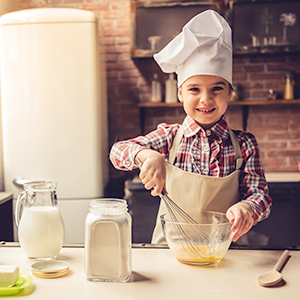Kids today often lag behind those of previous generations in their cooking
skills. That’s because in today’s fast-paced society, fewer parents have
the time or energy to cook. As a result, families rely more on fast food
and eating out.
But teaching kids food preparation and how to cook offers them numerous
benefits. For one, it’s a practical and fun way for kids to learn and
improve their math skills through measuring and calculating. It also
provides kids hands-on science experiences and opportunities to experiment.
Another valuable aspect of cooking is that it improves kids’ reading
comprehension as they learn to follow step-by-step instructions. Add to
this, kids develop life skills which boost their self-confidence and
self-esteem.
So it’s important to begin teaching kids kitchen skills when they’re small.
Kids as young as 3 can learn simple food preparation skills. They can cut
food using a plastic or butter knife, pour premeasured ingredients, spread
sauces or batters and stir.
During the early elementary years, kids can learn how to turn on and off
the stove and some simple cooking skills. For example, they can learn to
make scrambled eggs and warm up soup. At this age, they also need to learn
safety rules, particularly as they relate to the more advanced cooking and
food preparation skills they’re learning.
Preteens should learn how to safely use a sharp knife. They can also learn
to cook slightly more advanced foods, while also continuing to learn about
food and cooking safety.
Once kids reach their teens, they no longer require supervision in the
kitchen. Not only can they prepare meals for themselves but also for the
family.
Restaurant play
Even before their teen years, kids can enjoy some semi-independent kitchen
fun by playing restaurant. This way they can gradually ease into
independent cooking. By the age of 8, kids likely have enough kitchen
skills for this activity.
Advance preparation
First, share the details of this activity with your child, then have your
child prepare a list of foods he or she knows how to make. For younger
kids, the menu might include cold sandwiches, grilled cheese sandwiches,
peeled and cut vegetables or fruit, scrambled or fried eggs and other
easy-to-prepare foods.
Your preteen’s menu could include hamburgers, pancakes, soup, roasted
vegetables and much more.
And for teens, the sky’s the limit. If your teen chooses dishes that
require a long time to prepare or cook, you’ll likely want to ‘call in’
your food order before arriving at the restaurant.
Once your child has come up with dishes for the menu, review the list to
make sure they’re foods your child can prepare safely with minimal
supervision.
Pick a date for the restaurant activity, and make sure ingredients are
available for everything on the menu.
Also, decide who will patronize your child’s restaurant. If it’s your
child’s first time playing or your child is young, two to three family
members will be plenty. Older kids might be able to handle an extra guest
or two depending on their skills and the complexity of the menu.
Design the menu
Before your child creates the menu, help them set prices for the entrees.
The prices should be substantially below real restaurant prices, especially
since you’re footing the bill for the groceries. Remember, the idea behind
this activity isn’t about the money. It’s supposed to be a fun learning
experience for your kids. Still, charging for the food can add to the
activity and gives your kid a chance to do some simple math.
The next step is for your child to design a menu. Younger kids can make
menus out of construction paper. They can also clip food pictures from
magazines or print them off the internet.
Older kids might want to experiment with some graphic design. If your child
has already dabbled with graphic design, they might want to try Adobe
Photoshop or Illustrator. Otherwise, a simpler app is better so your child
doesn’t get frustrated and turned off to graphic design. Canva’s free menu
templates are a good option. Visit
canva.com/menus.
Grand opening
Now the real fun begins. When your child’s restaurant opens, wait at the
kitchen or dining room entry and allow your host to seat you. Your server
will bring you menus and water and take your order when you’re ready.
As parents, you might be tempted to make it easy on your child by
encouraging everyone to order the same thing. But unless your child has
expressed concern about preparing multiple items, try to choose a variety.
This is part of the fun and challenge for your child.
After you’ve ordered, relax and enjoy some family conversation – and be
prepared for a possible long wait. Also, avoid instructing your child
unless you see something potentially dangerous.
Graciously thank your waiter (and cook) when your food arrives and be
prepared to eat it regardless of how it turns out. If you’re tempted to
offer your child some constructive criticism, don’t. This should be a fun
experience that encourages a love of cooking. Your child will improve with
experience. If you really feel you have something to contribute to your
child in the way of cooking a particular food, just wait until the next
time you make it. Then you can nonchalantly give tips on how to make that
dish turn out really tasty.
Finally, your child should prepare and give you a check so you can pay for
your meal.
Clean up
Be sure to let your child know in advance about the responsibility for
cleanup. Hopefully, this will help your child keep the mess to a minimum,
and if it doesn’t, it’ll be a good lesson for the next time.

